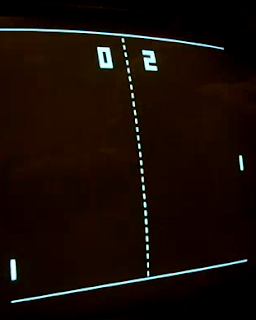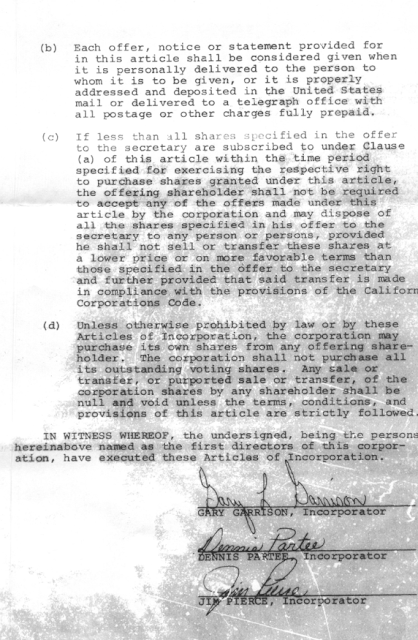Cinematronics might seem an odd choice for a long series of posts given that there are already two sites documenting its history (http://www.zonn.com/Cinematronics/history.htm and http://www.cinematronics.org/history.html) plus Tim Skelly's write-up in Before the Crash but I have a good deal of info on the company that hasn't seen the light of day so far plus most of the histories leave out the pre-1977 and the post-vector era.
In some of these posts, I will retain the chapter titles from the book.
Enough with the preliminaries:
Chapter 14
Spacewar Returns – The Rise of the Vector Game
(Cinematronics: 1975-1978)
Cinematronics was founded in April 1975 in Kearny Mesa, a community in east San Diego, by Gary Garrison, Dennis Partee, and Jim Pierce. It was an unlikely combo to start a video game company. Two of the three were pro football players and the other was a farmer. Garrison and Partee were members of the NFL’s San Diego Chargers. Partee had been the team's kicker and punter since 1968 and would retire after the 1975 season. Known as "the ghost", Gary Garrison joined the team in 1966 and in the late 60s teamed with Hall-of-Famer Lance Alworth to form one of the AFL’s premiere pass-catching combos. He would stay with the Chargers through 1976 and retire in1977 after a brief stint with the Houston Oilers.
 |
| Dennis Partee's 1975 Topps football card. Gary Garrison's 1971 Topps football card. |
While Partee and Garrison's interest in the venture soon waned, the third member of the trio, Jim Pierce, stayed with the company until the bitter end. Jimmie Dale Pierce was born in Missouri on February 17, 1937. In the 1970s, Pierce, who once described himself as "a tractor driver from El Centro," was a beet farmer in Imperial Valley, an oasis in the middle of the Sonoran Desert in southeastern California (Rhoades 1975). In 1975, he left his tractor behind, and headed to San Diego to try his luck in the booming cocktail video game market, joining Partee and Garrison in their new venture with an initial investment of $21,000 (San Diego Union 1/14/79). On April 11, 1975, the three appeared before notary public Cheryl Richardson to file articles of incorporation and on May 16, Cinematronics was incorporated.
 |
From the May 25, 1975 Airzona Republic |
 |
| Jim Pierce From Before the Crash: Early Video Game History (original source, Replay magazine) |
Cinematronics’s early years are shrouded in mystery. Prior to late 1976, the company drew no mention whatsoever in the trade journals, which covered even the smallest manufacturers. Its first game was a cocktail table Pong clone, produced around May 1975 but details are sketchy at best. No flyer has ever turned up and it is unclear how or where they were sold. Not even the name is known with any certainty, with some referring to it simply as "Pong." Most sources agree that it was an illegitimate copy of an existing game, but accounts vary regarding how it came about, even among those who later worked for the company. Tim Skelly (2007) reports that Cinematronics ordered schematics for another game and built a knockoff, while Robert Shaver (2012) heard that they stripped the components from an existing board, then photographed it to make artwork for a new one. The most interesting version, which was still making the rounds at Cinematronics years later, claims that the founders visited a rival company and tried to buy its Pong clone, only to be rebuffed. As they were leaving they noticed a stack of PC boards behind the building, commandeered a few, and beat a hasty retreat (Skinner 2012).
 |
| Rare photo of Cinematronics' 1975 Video Amusement Table From http://www.youtube.com/watch?v=TfWJmIxI77A |
Sidebar - Cinematronics'
Pong Clone
The story of the "procurement" Cinematronics'
first game is unsubstantiated. If it is true, however (and that's a big "if"),
who made the original? We'll probably never know. At the time, most video
games companies in California were in the Silicon Valley 500 miles to the North
with a handful of others in the Los Angeles area. There were very few in San
Diego. Gremlin was still making wall games at the time. They wouldn't release their
first video game until late 1976 and they never made a Pong clone. Of course, there could have been any number of
fly-by-night video game companies in San Diego that have since disappeared into
the mists of history. One such company was Video Tennis, Inc., incorporated November
7, 1974 in La Jolla - a company that has gone completely unmentioned until now. Another possible source
for the game is Amalgamated Enterprises located at 4867 Mercury, about a mile
from Cinematronics. Amalgamated wasn't incorporated until October of 1975
(around the same time they released a cocktail Pong clone called The Money
Game), but they had been in existence since at least late July. In early 1974 a
company called Amalgamated Industries (located at 7401 Convoy Court, next door
to Cinematronics) introduced a cocktail Pong clone called TV Tennis to San Diego bars but it appears that they were a distributor,
not a manufacturer. Then again, the whole
story could be apocryphal.
More mysterious still, in 1976, Cinematronics produced a home version of the game, which it sold through local department stores and about which even less is known. (Rhoades 1976). Not much more is known about Cinematronics’s second game – a video pinball game called Flipper Ball – beyond what can be gleaned from its flyer. Yet again, the game was not original, as it appears to have been identical to Exidy's TV Pinball. Aside from these fleeting references, almost nothing has turned up about the company's first two games.
 |
7335 Conway Court (site of Cinematronics ????-1977) today.
|
It appears that
neither Garrison nor Partee took much interest in the company. At the time of
its founding, both had recently been named VPs of San Diego Federal Bank and
had a number of other outside interests. Both were still active NFL players and
ran a football camp during the off-season. Garrison also raised quarter horses
and owned 61 apartment units in La Jolla.
Perhaps due to the lack of attention, Cinematronics lost money in its first year and didn’t do much better the next. The company did, however, begin to design games of its own. Robert Shaver came to work for Cinematronics in July of 1976. After graduating from Cal Poly, Shaver knew he wanted to live in San Diego. He drove his one-ton Chevy Step Van the 300 miles from San Luis Obispo then took a bus back home to get his car. Fresh out of college and short on cash, Shaver lived out of his van for the next two weeks as he scoured the want ads for a job in the electronics industry.
[Robert Shaver] One afternoon…as I was walking across a parking lot of a company
office having filled out another in that seemingly endless succession of
application/resume drudgery, I happened to look over my shoulder and saw a
company name that ended in “tronics”…I was tired and it was 4PM. I almost
walked on … but I didn’t. I walked back, entered the office and asked if they
were hiring. The receptionist (who I later learned was Jim Pierce’s
wife) handed
me an application. I filled it out, handed it back with a copy of my resume and
turned to leave. But she asked me to wait while she took it into the “boss”.
 |
| Engineer (later plant manager) Lou Newell From www.cinematronics.org (original source unkonwn, probably Replay or Play Meter) |
Meanwhile, Cinematronics
released a video pinball game called Flipper
Ball (a version of Chicago Coin's TV
Flipper, which itself was probably a licensed version of Exidy's TV Pinball). The game came in upright
and cocktail models.
In early 1977, sweeping changes were made. Garrison sold his share of the
company to Pierce and Ralph Clarke, owner of Charter Mortgage Company of San
Marcos. Pierce hired Chicago Coin's Bob Sherwood as marketing director and
moved the company from Kearny Mesa to El Cajon. Sherwood soon lined up so many
new clients that the company found itself two months behind filling orders. By
April, Shaver's game - Embargo was
ready for release.
 |
| Screenshot from Embargo |
In the game, the player
planted mines around a pair of islands that looked vaguely like Cuba with a canal through the middle of it (which may explain why it reportedly sold well in South Florida but nowhere else). The canal was a late addition suggested by Jim Pierce to give the player more manueveirng options . After designing the game, Shaver was assigned to a technician
job (Cinematronics had no technicians at the time) where he would repair Embargo boards as they came off the assembly
line (almost none of which were working when he got them). Shaver didn't care
for life as a technician and soon left. Sometime after the release of Embargo, Dennis Partee sold his interest in the company. By early
1978 he had gone into the retail doughnut business in Rancho Mission Plaza.
While the company's fortunes seem to have improved initially after Pierce took
over, the good times didn't last long. By late 1977, the company was
nearing bankruptcy (Pierce had already been through one) and in desperate need
of a hit.
 |
1044 Pioneer Way today. Cinematronics moved here in early 1977.From Google Maps |
[1] San
Diego Union September 10, 1975
[2] Flipper
Ball was a cocktail version of Chicago Coin's TV Flipper (which was released arund January, 1975) and probably
the same as Exidy's TV Pinball (which
debuted at the 1974 MOA show). While it is often listed as a 1977 game, that
date seems awfully late given the release dates of the earlier games. On the
other hand, flyers for Flipper Ball
bill it as "another" money maker from CInematroncis.
[3] Another home
game was also in development at the time, but I've found no other reference to
either of them.







Great stuff, keep it up!
ReplyDeleteEmbargo was one of the better machines of those times in my opinion.
ReplyDeleteI remember playing at the voodoo-gaming salon :D
I have so many memories with this machine, childhood on the whole :D
ReplyDelete_______
myDevil.NET
according to me at that time there were other, more interesting game machines
ReplyDelete__________
http://tdcpolska.pl/rozwiazania-digital-signage/